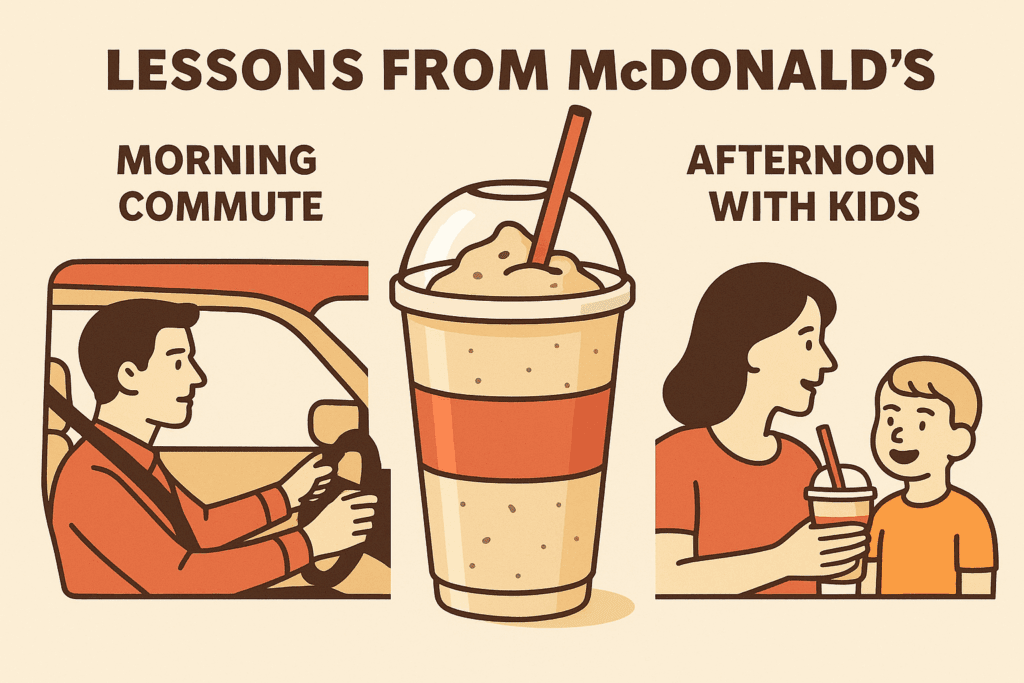Brief Summary

Clayton Christensen and his team helped a fast-food chain discover that morning commuters were “hiring” milkshakes to make their boring drives more engaging and stave off hunger, while afternoon customers wanted something different.
By reshaping the product based on those distinct “jobs,” the brand significantly grew sales and set a new standard for product positioning.
Company Involved
Marketing Topic
- Product Positioning
- Customer Experience
- Strategy
Public Reaction or Consequences
Customers noticed a more satisfying morning shake, but what made waves was the shift in corporate thinking: moving from demographic-based design to a deep focus on customers’ real-life contexts.
Why It Matters Today
Recognizing context-driven need is critical amid today’s AI‑driven personalization efforts. JTBD helps marketers understand underlying motivations beyond basic user profiles. Useful for product design where convenience and real‑world usage matter.
3 Takeaways
- Segment by situation, not just demographics.
- Ask what job the customer is hiring your product to do.
- Tailor the experience for different contexts to unlock new value.
Notable Quotes and Data
- “Forty percent of the milkshakes were purchased first thing in the morning, by commuters.”
- One customer said: “When I hire this milkshake… it takes me more than 20 minutes to suck it up… I’m full all morning and it fits right here in my cupholder.”
- “The milkshake was not just a product. It was a solution to a very specific problem.” – Clayton Christensen
Full Case Narrative
In the late 1990s, McDonald’s struggled to boost milkshake sales despite efforts based on traditional demographic and attribute testing. They brought in Clayton Christensen, who observed sales patterns and interviewed customers. He noticed that nearly half of milkshake purchases occurred during the morning commute—and were consumed in cars.
Those commuters needed something that would occupy their time, be consumed neatly with one hand, and stave off hunger until later.
Christensen emphasized that customers do not just buy products — they “hire” them to do a job in their lives. Milkshakes were hired to keep commuters entertained, full, and mess-free during a long drive — not just as a breakfast food.
Christensen framed this as a “job to be done”: providing sustained, engaging breakfast on the go. Understanding this, McDonald’s introduced thicker shakes with fruit chunks and improved drive‑through speed, making the shakes last longer. In the afternoon, recognizing that parents buying shakes for their kids wanted something easier to drink, they served thinner variants. This dual‑product strategy, rooted in situational insight, supercharged sales.
Timeline
- ~1997: McDonald’s requests help improving milkshake sales.
- 18‑hour observation: Large share of sales occur during morning rush.
- Customer interviews: Uncover distinct JTBDs for AM commuters and PM parents.
- Product adjustments: Introduce thicker shake and drive‑through optimizations.
What Happened Next?
McDonald’s continued tailoring shakes while expanding JTBD thinking to other menu items. The framework inspired a wave of purpose‑driven innovation across retail and tech industries, influencing companies such as FedEx, IKEA, and P&G.
The JTBD framework became a foundational tool in product development and marketing strategy, leading to more empathetic design across tech, retail, and service industries. Harvard Business School and innovation consultancies continue teaching it today.
One Sentence Takeaway
This case proves that breakthrough marketing does not always come from more data. Sometimes it comes from better questions.
Sources and Citations
Clay Christensen’s Milkshake Marketing at HBS Working Knowledge (includes video of Clay explaining their research and findings)
Clayton Christensen’s Jobs to Be Done framework at Fullstory
The Re‑Wired Group’s “Milkshakes in the Morning – The JTBD Story”
